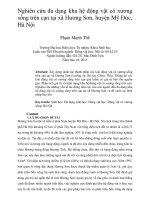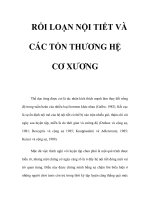Hệ cơ xương (English)
Bạn đang xem bản rút gọn của tài liệu. Xem và tải ngay bản đầy đủ của tài liệu tại đây (269.13 KB, 6 trang )
SKELETAL MUSCLE
1. Structure and function
Skeletal muscles (commonly referred to as muscles) are organs of the
vertebrate muscular system that are mostly attached by tendons to bones of the
skeleton. The muscle cells of skeletal muscles are much longer than in the other
types of muscle tissue, and are often known as muscle fibers. The muscle tissue of
a skeletal muscle is striated – having a striped appearance due to the arrangement
of the sarcomeres.
Skeletal muscles are voluntary muscles, meaning you control how and when
they move and work. Nerves in your somatic nervous system send signals to make
them function. If you reach for a book on a shelf, you’re using skeletal muscles in
your neck, arm and shoulder.
Function
The skeletal muscles are a vital part of your musculoskeletal system. They serve a
variety of functions, including:
- Chewing and swallowing, which are the first parts of digestion.
- Expanding and contracting your chest cavity so you can inhale and exhale at
will.
- Maintaining body posture.
- Moving the bones in different parts of your body.
- Protecting joints and holding them in place.
2. Skeletal Muscle Structure
A skeletal muscle contains multiple fascicles – bundles of muscle fibers.
Each individual fiber, and each muscle is surrounded by a type of connective tissue
layer of fascia. Muscle fibers are formed from the fusion of developmental
myoblasts in a process known as myogenesis resulting in long multinucleated cells.
In these cells the nuclei termed myonuclei are located along the inside of the cell
membrane. Muscle fibers also have multiple mitochondria to meet energy needs.
Muscle fibers are in turn composed of myofibrils. The myofibrils are
composed of actin and myosin filaments called myofilaments, repeated in units
called sarcomeres, which are the basic functional, contractile units of the muscle
fiber necessary for muscle contraction. Muscles are predominantly powered by the
oxidation of fats and carbohydrates, but anaerobic chemical reactions are also used,
particularly by fast twitch fibers. These chemical reactions produce adenosine
triphosphate (ATP) molecules that are used to power the movement of the myosin
heads.
3. Types of muscle contraction
There are two primary types of muscle contractions. They are isotonic contraction
and isometric contraction. The types of contractions depend on the changes in the
length and tension of the muscle fibres at the time of its contraction.
Isotonic contraction (iso – same, tonweight/resistance) In isotonic contraction the
length of the muscle changes but the tension remains constant. Here, the force
produced is unchanged. Example: lifting dumb bells and weightlifting. Isometric
contraction (iso – same, metric – distance)
In isometric contraction the length of the muscle does not change but the tension of
the muscle changes. Here, the force produced is changed. Example: pushing against
a wall, holding a heavy bag.
Types of Skeletal Muscle Fibres
The muscle fibres can be classified on the basis of their rate of shortening, either
fast or slow and the way in which they produce the ATP needed for contraction,
either oxidative or glycolytic. Fibres containing myosin with high ATPase activity
are classified as fast fibres and with lower ATPase activity are classified as slow
fibres.
Fibres that contain numerous mitochondria and have a high capacity for oxidative
phosphorylation are classified as oxidative fibres. Such fibres depend on blood
flow to deliver oxygen and nutrients to the muscles. The oxidative fibres are termed
as red muscle fibres.
Fibres that contain few mitochondria but possess a high concentration of glycolytic
enzymes and large
Skeletal muscle fibres are further classified into three types based on the above
classification. They are slow – oxidative fibres, fast – oxidative fibres and fast –
glycolytic fibres.
Slow – Oxidative Fibres
Have low rates of myosin ATP hydrolysis but have the ability to make large
amounts of ATP. These fibres are used for prolonged, regular activity such as long
distance swimming. Long – distance runners have a high proportion of these fibres
in their leg muscles.
Fast – Oxidative Fibres
Have high myosin ATPase activity and can make large amounts of ATP. They are
particularly suited for rapid actions.
Fast – Glycolytic Fibres
Have myosin ATPase activity but cannot make as much ATP as oxidative fires,
because their source of ATP is glycolysis. These fibres are best suited for rapid,
intense actions, such as short sprint at maximum speed.
Isometric:
A muscular contraction in which the length of the muscle does not change.
Isotonic:
A muscular contraction in which the length of the muscle changes.
Eccentric:
An isotonic contraction where the muscle lengthens.
Concentric:
An isotonic contraction where the muscle shortens. Types of Contractions. There
are three types of muscle contraction: concentric, isometric, and eccentric.
Isometric:
Of or involving muscular contraction against resistance in which the length of the
muscle remains the same.
Isotonic:
Of or involving muscular contraction against resistance in which the length of the
muscle changes.
The process of muscular contraction occurs over a number of key steps, including:
Depolarisation and calcium ion release.
Actin and myosin cross-bridge formation.
Sliding mechanism of actin and myosin filaments.
Sarcomere shortening (muscle contraction)
Isotonic contractions – These occur when a muscle contracts and changes length
and there are two types:
Isotonic concentric contraction – This involves the muscle shortening.
Isotonic eccentric contraction – This involves the muscle lengthening whilst it is
under tension.
The first step in the process of contraction is for Ca ++ to bind to troponin so that
tropomyosin can slide away from the binding sites on the actin strands. This allows
the myosin heads to bind to these exposed binding sites and form cross-bridges.
Abstract. Skeletal muscle is one of the most dynamic and plastic tissues of the
human body. In humans, skeletal muscle comprises approximately 40% of total
body weight and contains 50-75% of all body proteins.
Skeletal muscles only pull in one direction. For this reason they always come in
pairs. When one muscle in a pair contracts, to bend a joint for example, its
counterpart then contracts and pulls in the opposite direction to straighten the joint
out again.
This is a table of skeletal muscles of the human anatomy. There are around 650
skeletal muscles within the typical human body. Almost every muscle constitutes
one part of a pair of identical bilateral muscles, found on both sides, resulting in
approximately 320 pairs of muscles, as presented in this article.









